Beretta M9A3 9mm Pistol, 4.9" Barrel, Tritium Night Sights, Flat Dark Earth – JS92M9A3 For Sale
$1,006.99
The Beretta M9A3 9mm Pistol combines tactical innovation and practical functionality, featuring a 4.9″ barrel and Tritium Night Sights. Designed for military, law enforcement, and VIP protection, its Flat Dark Earth finish enhances durability and aesthetics. This pistol exemplifies Beretta’s dedication to excellence, offering reliability and precision for tactical operations, personal and home defense, and competitive shooting. The M9A3 is not just a firearm, but a comprehensive solution for those requiring superior performance and versatility in the field.
Is the Beretta M9A3 discontinued?
Yes, the Beretta M9A3 has been discontinued.
Why did the army reject the M9A3?
The U.S. Army rejected the M9A3 upgrade proposal primarily because it was seeking a more comprehensive solution for its sidearm needs. Rather than upgrading the existing M9 pistol, the Army wanted a more modern and modular firearm. The M9A3 was an improved version of the M9 with several enhancements, including a threaded barrel, improved ergonomics, and better sights. However, these upgrades did not meet the Army’s goal of adopting a new generation pistol through its Modular Handgun System (MHS) program. The MHS program aimed to find a service pistol with advanced features, higher performance, and greater adaptability. This led the Army to eventually choose the SIG Sauer P320, which was adapted into the M17 and M18 pistols, as they better fulfilled the requirements of a modern, adaptable, and versatile sidearm platform.
What is the difference between M9A3 and M9A4?
The M9A3 and M9A4 are variations of the Beretta M9 series pistols, with several differences in features and enhancements.
1. **Design and Ergonomics:**
– The M9A4 features further refined ergonomics over the M9A3. It typically includes more aggressive grip texturing and improved checkering for better handling.
2. **Optics Compatibility:**
– The M9A4 includes a factory-cut slide to support optics mounting, which makes it compatible with a range of red dot sights without the need for additional modification. The M9A3 does not have this feature, which is one of the most significant distinctions.
3. **Sight Options:**
– While both models might offer similar sight options, the M9A4’s optics-ready nature gives it an edge in offering enhanced sighting options.
4. **Controls and Safety:**
– Both models feature similar ambidextrous controls, but the M9A4 might incorporate slightly refined controls for improved operation based on user feedback on prior models.
5. **Barrel and Suppressor Compatibility:**
– The M9A4 may feature upgrades for suppressor compatibility to a greater extent than the M9A3, although both models can support threaded barrels for suppressor attachment.
6. **Finish and Coating:**
– Both versions feature a durable coating, but there may be subtle differences in the type or color of finishes offered.
These enhancements in the M9A4 are aimed at improving user experience through advanced modularity, maintaining the reliability and durability of the preceding models while adding options for tactical features and customizations.
Is Beretta M9 better than 92FS?
The Beretta M9 and the Beretta 92FS are very similar, as the M9 is essentially a military designation for a version of the 92FS. Here are a few differences and considerations:
1. **Usage**: The M9 is the standard issue sidearm for the United States Armed Forces, while the 92FS is available for civilian markets and law enforcement.
2. **Design and Features**: Both are very similar in design. The primary differences are minor, often related to quality control processes and markings. For example, the M9 might have slight variations in grip texture or markings compared to the 92FS.
3. **Specifications**: The technical specifications like barrel length, magazine capacity, and operating mechanisms are nearly identical.
4. **Preference and Intended Use**: Choosing between them often comes down to preference or specific needs. Some users prefer the civilian 92FS for its availability and sometimes more polished finish, while others prefer the M9 for its military pedigree.
Ultimately, whether one is better than the other depends on personal needs and preferences. They are effectively the same weapon with minor differences.
What Beretta did the Navy SEALs use?
The Navy SEALs have used the Beretta M9 as their standard-issue sidearm. However, within the Naval Special Warfare community, the SEALs often preferred the Beretta 92FS, a version of the M9, due to its reliability and performance.
Why is Beretta so expensive?
Beretta products are often considered expensive due to several factors. Firstly, Beretta is one of the oldest and most prestigious firearms manufacturers in the world, with a history that dates back to 1526. This long-standing reputation for quality and craftsmanship contributes significantly to their pricing.
Secondly, Beretta invests heavily in research and development to ensure that their firearms incorporate the latest technology and safety features, leading to superior performance and durability. Their products are often manufactured using high-quality materials and rigorous quality control, which also adds to the cost.
Additionally, Beretta firearms are often handcrafted by skilled artisans, a process that is both time-consuming and costly. The brand’s focus on producing premium products with attention to detail means that they cater to a market that values these characteristics, allowing them to command higher prices.
Lastly, brand recognition and customer perception also play a role. Owning a Beretta can be seen as a status symbol, further enabling the company to set premium prices for their products.
What year did the Beretta M9A3 come out?
The Beretta M9A3 was released in 2015.
Why did the military stop using the Beretta M9?
The military began phasing out the Beretta M9 as its standard-issue sidearm primarily due to the handgun’s aging design and certain limitations in its performance compared to modern firearms. The Beretta M9, which had been in use since 1985, was replaced by the SIG Sauer P320, designated the M17 and M18, as part of the Modular Handgun System (MHS) program.
Key reasons for the transition included:
1. **Modularity**: The SIG Sauer P320 offered increased modularity, allowing for easy customization with different grips, calibers, and barrel lengths, which met the diverse needs of service members.
2. **Improved Performance**: The SIG Sauer P320 provided enhanced ergonomics, accuracy, and reliability. It also offered a higher capacity for rounds, contributing to its effectiveness in service.
3. **Safety Features**: The P320 included updated safety features that supplemented its overall operational capabilities, such as a striker-fired mechanism instead of the M9’s hammer-fired action.
4. **Durability and Maintenance**: The new P320 models were easier to maintain and more durable, reducing the long-term costs and logistical demands on the military.
These factors combined to make the SIG Sauer P320 a more suitable choice for modern military operations, prompting the replacement of the Beretta M9.
Does the M9A3 have a safety?
Yes, the Beretta M9A3 does have a safety. The M9A3 is equipped with an ambidextrous safety/decocker lever, allowing the user to both engage the manual safety and decock the firearm safely.
How accurate is the Beretta M9A3?
The Beretta M9A3 is known for its accuracy, which can be attributed to several design features. It has a 5.2-inch barrel that contributes to better bullet stability and accuracy over long distances. The pistol also features a Vertec-style thin grip which can enhance the shooter’s grip and control, leading to improved accuracy. Additionally, the M9A3 has a consistent trigger pull and high-visibility sights, further aiding in precise targeting. In practical terms, the M9A3 is generally considered to be quite accurate for a service pistol, often noted for its performance in various shooting conditions. However, individual accuracy can vary based on the shooter’s skill and experience.
Is the M9A4 decocker only?
No, the M9A4 is not decocker only. It features a safety decocker lever, allowing for both decocking and the option to engage the safety.
What is the effective range of the Beretta M9A3?
The effective range of the Beretta M9A3 is approximately 50 meters (about 55 yards).
What year did the Beretta M9A3 come out?
The Beretta M9A3 was introduced in 2015.
When did they stop making the Beretta?
Beretta has not stopped producing firearms overall. However, if you are referring to a specific model, such as the Beretta 92FS or another specific firearm, more detail would be needed to provide an accurate answer. As of the latest information available in 2023, Beretta continues to manufacture firearms. Please specify the model for more precise information.
Why did the military stop using the Beretta M9?
The U.S. military decided to replace the Beretta M9 with the SIG Sauer P320, designated as the M17 and M18, due to several reasons:
1. **Modularity:** The SIG Sauer P320 offers a modular design, allowing for easier customization and adaptability to different missions and user preferences with interchangeable grips and other components.
2. **Improved Performance:** The P320 was selected for its overall performance, including better ergonomics, trigger system, and ease of use and maintenance compared to the M9.
3. **Reliability and Durability:** The military sought a handgun that could better withstand harsh environments and heavy use, criteria that the P320 met more effectively than the aging M9.
4. **Advancements in Technology:** The P320 incorporates more modern firearm technology, aligning with the military’s goal of updating its arsenal with contemporary and future-ready equipment.
5. **Cost-Effectiveness:** The P320 also offered a more favorable cost-performance ratio in terms of procurement and lifecycle maintenance compared to the outmoded M9.
The decision to transition to the SIG Sauer P320 was part of the U.S. Army’s XM17 Modular Handgun System competition aimed at modernizing the sidearms used by military personnel.
Be the first to review “Beretta M9A3 9mm Pistol, 4.9" Barrel, Tritium Night Sights, Flat Dark Earth – JS92M9A3” Cancel reply
Related products
Beretta M9A3
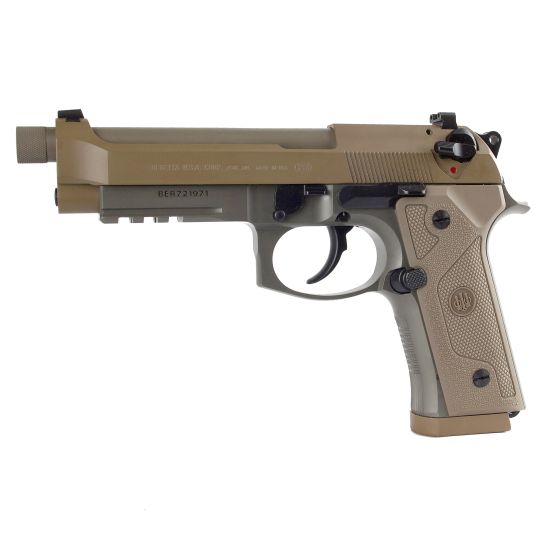
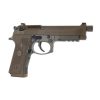
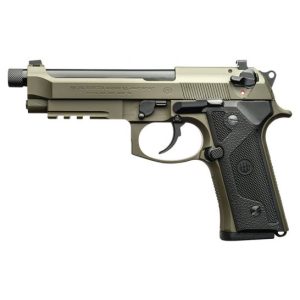
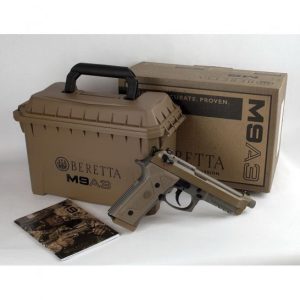
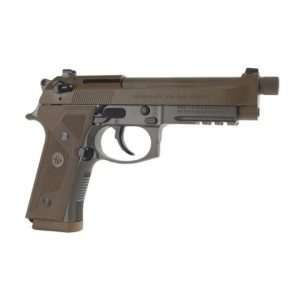
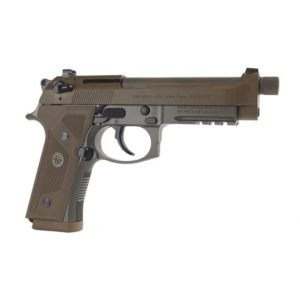
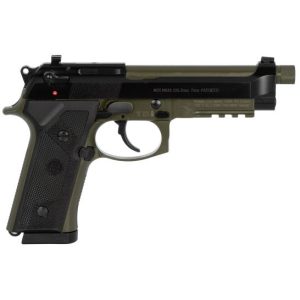
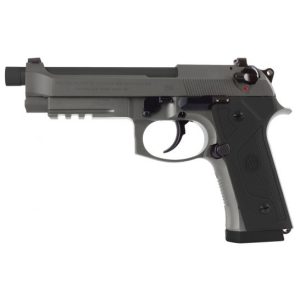
Reviews
There are no reviews yet.